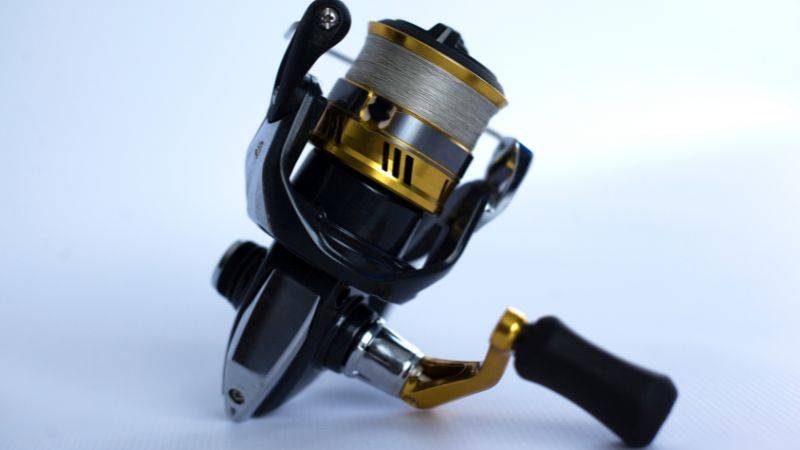
In this article we are going to learn, how to rig a soft plastic frog for fishing.
One type of bait that has gained popularity in recent years is the soft plastic frog. These lures mimic the movement of real frogs and can be used to catch a variety of fish, including big bass, pike and trophy size trout.
The soft plastics frog are effective, especially at around cover like weeds and for night fishing.
However, rigging a soft plastic frog can be a bit tricky, especially for those who are new to the sport.
Rigging a Soft Plastic Frog
Here are the steps to rig a soft plastic frog for fishing:
Step 1.

1. Pick the right size frog for the fish you are targeting. Choose the right hook that fits the size of the frog you are using.
Have a look on the soft plastics frog pack to see if it suggest a hook size or type. A lot of brands will suggest a weedless design hook.
The most common hook used for rigging a soft plastic frog is an extra wide gape hook. It is designed to fit the bulky body of the frog and provide a secure hookset.
Step 2.

- Place the hook alongside the frog. Take note where the hook will enter and come out of the soft plastic frog.
Step 3.
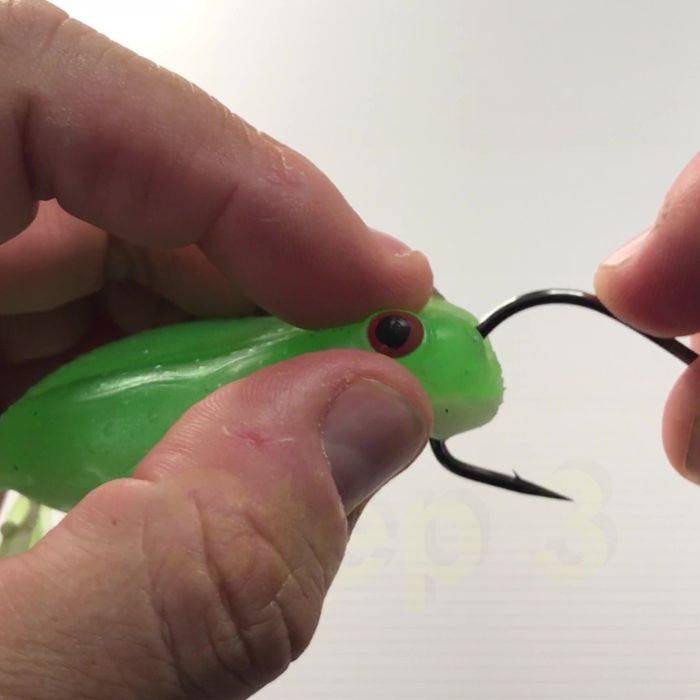
- Insert the hook into the nose of the frog and push it through.
Step 4.

- Push the hook through to near the eye of the hook.
Step 5.

- Rotate the hook around, so the 90 degree part of the hook shank is at the nose of the frog. This will stop the lure from sliding down the shank when retrieving it.
Step 6.
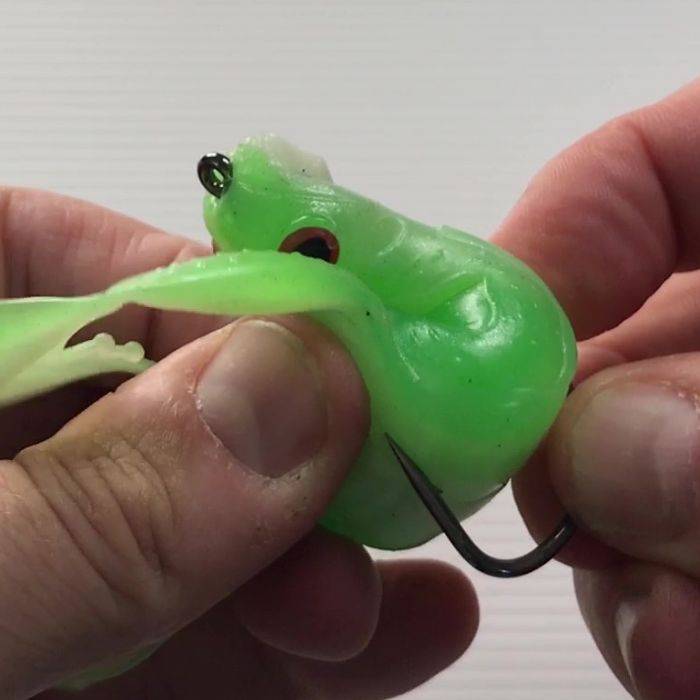
- Insert the hook through the end of the frog of where you took note in step 2.
Step 7.
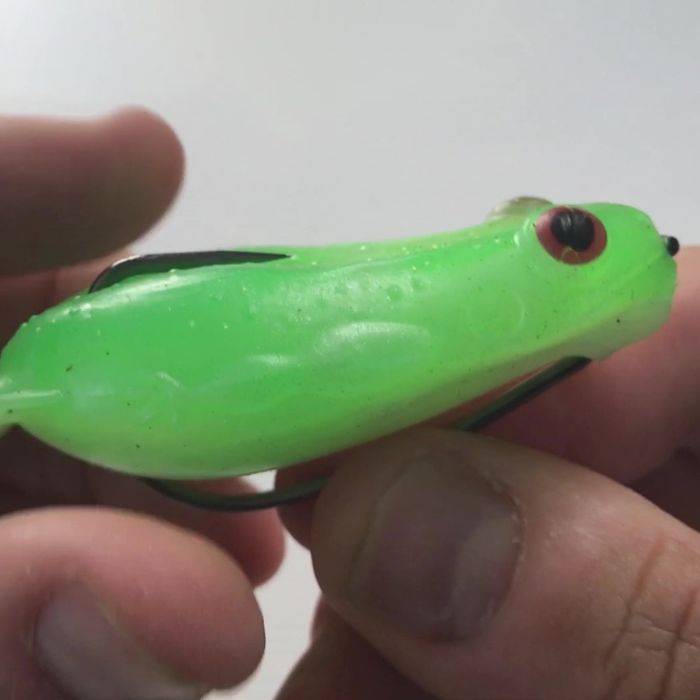
- Make sure the frog is on straight. Re-rig the lure if it is crooked.
Retrieve the frog: See if the frog looks good on the water and what its movement is like. If it is leaning to one side or has minimal action, try rigging the frog again.
Optional:

If the soft plastic frog doesn’t have a slit for the hook, you can make one. Make a slit: Using a sharp knife or scissors, make a slit in the back and belly of the soft plastic frog. This will allow the hook to lay flat against the body of the frog, making it more weedless and less likely to snag on vegetation.
With these steps and a bit of practice, you should be able to rig a soft plastic frog for fishing within a minute.
Correct rigging will increase your chances of catching more fish as it will have better action.
See also – How to Rig a Z-Man Soft Plastic Grub
You can also put the frog on a weighted jig head, or weights like football weights on the frog. The weight helps cast the frog out further and can be useful for fishing it sub surface.
Some frog baits can also be used as a big trailer for a skirted jig, or on a spinnerbait for sub surface fishing.
To learn how and ways to store the soft plastics correctly, visit – How To Store Soft Plastic Lures
The right rigging technique can make all the difference in getting the lure to have a good action on top or in the water.
Also good rigging helps to have good hook set when the fish strikes. (Otherwise the plastic can get in the road of the tip of the hook.)
Why Use a Soft Plastic Frog for Fishing?

Soft plastic frogs are a popular choice among anglers due to their versatility and effectiveness in catching bass and other aggressive fish species.
(My father used to bait fish with live frogs for bait and did the fish take them aggressively. It was very exciting fishing, especially at night time when you heard the bass and trout strike and thrash about.)
Today the soft plastics have made fishing easier, with a wide selection of types of baits like worms, curly tails, crawfish and realistic action frogs.
Here are a few reasons why you should consider using a soft plastic frog for your next fishing trip:
- Topwater action: Soft plastic frogs are designed to float on the surface of the water, mimicking the movement of a real kicking frog. This makes them a great choice for topwater fishing, which can be an exciting and adrenaline-filled experience.
- Great for heavy cover: Because of their weedless design, soft plastic frogs are ideal for fishing in heavy cover. They can be worked over lily pads, grass mats, and other vegetation without getting snagged, making them a go-to choice for bass anglers looking to target fish in these areas.
- Realistic appearance: Soft plastic frogs are available in a variety of colors and patterns, allowing you to choose one that closely resembles the frogs found in your local fishing spot. This can make them more appealing to bass and increase your chances of getting a bite. (Some of the older designs were awful and had no movement.)
- Easy to rig: Rigging a soft plastic frog is relatively simple once you have done it a couple of times. It can be done in a variety of ways to suit your fishing style. Whether you prefer a weightless rig, or a weighted jig head, there is a rigging method that will work for you.
Overall, soft plastic frogs are a versatile and effective bait choice for bass fishing. Their topwater action, weedless design, realistic appearance, and ease of rigging make them a go-to choice for many anglers.
Types of Soft Plastic Frogs
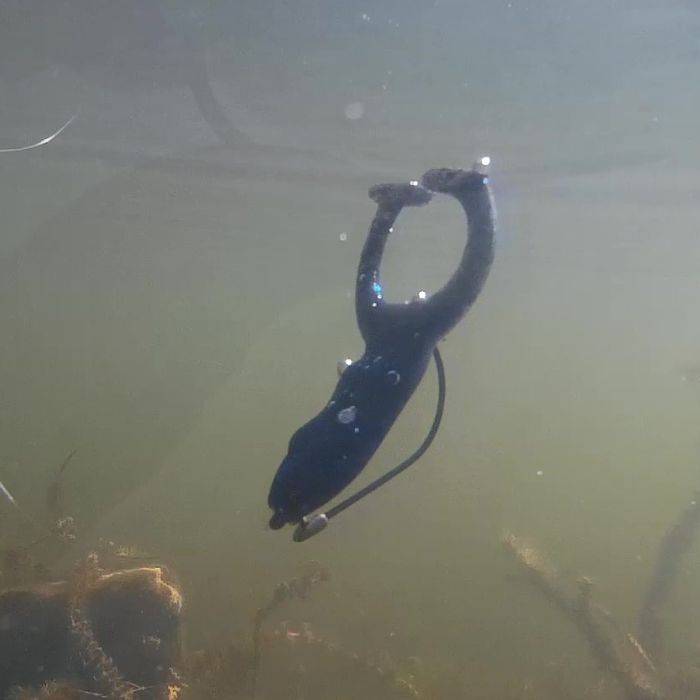
When it comes to fishing with soft plastic frogs, there are a variety of types to choose from. Here are a few designs:
- Hollow Body Frogs: These frogs are designed to float on the surface of the water, mimicking the behavior of a real frog. They have a hollow body that collapses when a fish bites, allowing for better hooksets. Some popular hollow body frogs include the Spro Bronzeye Frog and the Booyah Pad Crasher.
- Soft Body Frogs: These frogs have a solid body and some are designed to sink below the surface of the water. They are often used for fishing in heavy cover. Some popular soft body frogs include the Zoom Horny Toad and the Strike King Rage Tail Toad.
- Popping Frogs: These poppers or frog designs have a concave face that creates a popping sound when retrieved across the surface of the water. This sound can attract fish from a distance and entice them to strike. Some popular popping frogs include the Booyah Poppin’ Pad Crasher and the Rebel Pop-R Frog.
When choosing a soft plastic frog, consider the conditions you will be fishing in and the behavior of the fish you are targeting.
Gear for Rigging the Frog and Fishing Tips

Before rigging a soft plastic frog for fishing, you need to make sure you have the right equipment. Here are the essentials:
- Soft plastic frog: Choose a soft plastic frog that is the right size and color for the type of fish you are targeting. Consider the hook size you plan to use and make sure the frog fits well on the hook.
- Hook: Is it a weedless design, do you want a weighted or unweighted hook? Use a wide gape hook to allow a hook up, even with the big body of the frog.
- Fishing Line: The exact poundage you use will depend on the species and general size in your local waters. Fish will take the frog aggressively as they don’t want it to swim away fast. So use a strong fishing line that can handle the weight of the fish you are targeting. A heavy poundage line is the way to go, perhaps a bit heavier then what you normally use. But not so heavy it interferes with the lures swimming action.
- Rod and reel: Choose a rod and reel that is appropriate for the size of the fish you are targeting. A medium to heavy action rod with a fast tip is ideal for frog fishing because it can help you set the hook quickly and accurately and still have some backbone for a big bass or fish.
- Practice Rigging the Frog: Practice at home in a relaxed, controlled place. Rather than in a windy boat or at night time where it makes things more difficult to rig it for the first time.
By having the right equipment, you can increase your chances of success when rigging a soft plastic frog for fishing.
Brands of Soft Plastic Frogs
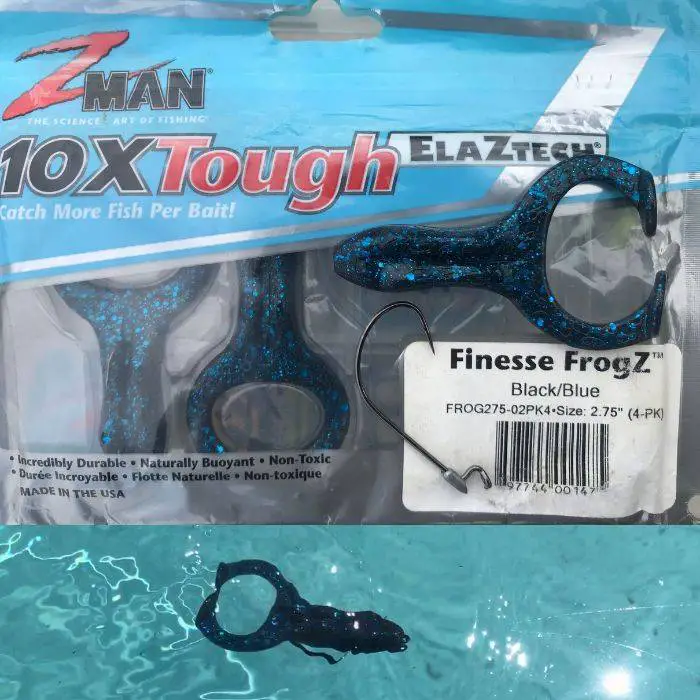
A lot of lure and soft plastic bait companies have one or more type versions of frogs. Here are a few brands and types:
- Zoom Baits Floating Frog
- Zoom Swimmin Chunk
- Zoom Bull Frog
- Zoom Horny Toad
- ZOOM Tree Frog
- Live Target Frog
- Z-Man Micro Finesse 2.75” Frogz
- Z-Man 3.75” Frogz
- Spro Bronzeye Frog
- Booyah Pad Crasher
- Chase Baits Flexi Frog
- Daiwa Bait Junkie Kikker Curly
- Berkley Powerbait Paddle Frog Soft Plastic Lure
- Strike King KVD Frog
- Strike King KVD Perfect Plastics Gurgle Toad
- Strike King KVD Toad Buzz
- Booyah Poppin’ Pad Crasher
- Rebel Pop-R Frog
Some of these lures are pre-rigged.

Techniques for Fishing with a Soft Plastic Frog
Retrieve the frog by twitching the rod tip and reeling in the slack. This will make the frog hop and skip across the surface of the water, mimicking the movements of a real frog.
You can jerk the rod tip aggressively or just use shot twitches, mix it up and see what works best.
But the key is to create a lot of movement and pause between twitches to give the fish time to strike.

Here are some other techniques to help you catch trout, bass and other fish with a frog lure:
- Fishing in Vegetation: Soft plastic frogs are great for fishing in vegetation. Cast your lure into the weed beds and retrieve it slowly. The frogs will float on top of the weeds, making it look like a real frog is swimming on the surface of the water. Make sure to pause your retrieve every once in a while to let the frog sit on top of the weeds.
- Skipping: Another way to fish with a soft plastic frog is to skip it across the surface of the water. This technique works well when fishing around docks, under overhanging trees, or other structures. Cast your lure parallel to the structure, pause and retrieve it while giving it twitches and pause every once in a while.
- Walking the Dog: Walking the dog is another technique for fishing with topwater lures, including soft plastic frogs. Cast your lure out and retrieve it quickly while giving it a side-to-side motion, creating a pop with the jerks / twitches. This will cause the frog to “walk” across the surface of the water, making it look like a real frog is swimming.
Cast around structure and weeds. Be prepared for a few snags as the closer you can get to or under overhanging branches and undercut banks, the better.
Remember to use plenty of pauses as well, as a lot of the times a fish will strike the lure when paused.
Experiment with different techniques until you find the one that works best for you. Don’t be afraid to try new things and vary your retrieve speed to see what the fish are biting on.
Conclusion

Soft plastic frogs can be a great addition to your fishing arsenal, especially for targeting bass in heavy vegetation. They are versatile and can be rigged in different ways depending on the fishing conditions and your personal preferences.
Overall, when learning how to rig a soft plastic frog for fishing, you might need a little practice and experimentation. But by using frog lures, you can have some fantastic, explosive bass fishing, once you master it.
By following the tips and techniques outlined in this article, you can increase your chances of catching more and bigger fish in your favorite frogging spots.
Other articles you might be interested in:

